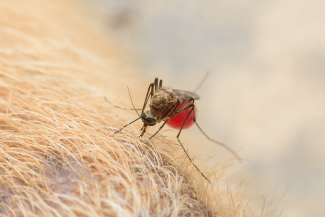
How your faithful pet can contract leishmaniasis
Leishmaniasis is a serious infectious disease that can be fatal to dogs. It is transmitted through the bite of a certain type of mosquito and, as well as having terrible consequences for our pets, it can also affect humans. The key to preventing it is knowing how it is transmitted so we can take preventive action.
Leishmaniasis in dogs (also known as leishmaniosis) is a parasitic disease caused by protozoa of the genus Leishmania. This parasite cannot live outside another organism, so it spends its life inside a mammalian host or a transmitting insect, agent or vector. It is a disease with a wide geographical distribution and high prevalence, which causes serious damage to health and even death. Furthermore, it is a zoonosis, which means it can be transmitted to humans.
Symptoms include skin lesions, especially on the head and legs, and on the mucous membranes, where bleeding occurs, particularly in the nose, and hair loss. It is also common that the animal gradually loses weight, but not its appetite. When the infection spreads to the organs, it usually causes a clinical condition known as visceral leishmaniasis, which can be fatal if not treated in time.
Why is it so difficult to control leishmaniasis?
In endemic areas (i.e., where the disease is highly prevalent), most infections are asymptomatic, meaning the animal does not show any symptoms. While this would appear to be good news, it is also the reason why the disease is so difficult to control and the risk of infection is always latent in the dog. The host population living with asymptomatic infections is known as a reservoir. In Europe, the main reservoirs of Leishmania are dogs—both domestic and stray—rodents, foxes and wolves.
Leishmaniasis is present throughout Spain and is a notifiable disease.
How is leishmaniasis transmitted?
The main mode of transmission is through the bite of the female phlebotomine sand fly, a tiny insect that feeds on the blood of mammals. It is similar to the mosquito, but much smaller, so it tends to go unnoticed. It usually lives for about two weeks and, although nocturnal, it is most active during twilight hours, so bites are more common at dawn and dusk.

Dogs cannot contract or transmit leishmaniasis through direct contact.
When the phlebotomine sand fly feeds on the blood of an animal infected with Leishmania, the parasite multiplies inside the insect, and migrates from the abdomen to the proboscis (a sharp proboscis the insect uses to bite). As a result, when the sand fly subsequently feeds on another dog, it not only feeds on its blood, but also transmits the parasite to it. A single bite is enough to infect the dog, as it can deposit up to one thousand Leishmania at a time.
Once the dog has been bitten by the insect, its immune system is activated to defend the body against Leishmaniasis, but unfortunately, this protozoan resides in macrophages (cells responsible for devouring and destroying intruders), so the parasite multiplies inside them until they burst. This releases many more parasites, which in turn infect new macrophages. Ironically, it is the immune system itself that spreads the disease to other host organs such as the bone marrow, spleen and liver.

This tiny insect hides under stones, in tree hollows and other places common on walks with our pets.
While in some cases the body learns to cope with the parasite, so that the disease seems to minimise or subside on its own, there is no evidence that the parasites are completely eliminated and when our four-legged friend's defences are lowered, the disease can reappear.
In humans, the bite of the infected insect is a risk, especially for children and people with low defences, which can cause disfiguring skin lesions, as well as the very dangerous visceral form of the disease.
How can we stop our dogs from becoming infected?
Prevention is, without a doubt, the best weapon against this dangerous disease. Although vaccines against canine leishmaniasis exist, they are not as effective as those used for other diseases. Once the animal is infected, symptoms may take weeks or even months to appear and treatment is usually very long. Moreover, where there is a reservoir, there is a risk of re-infection.
Since the key to the transmission of this disease is the sand fly bite, stopping it breaks the cycle. Therefore, the use of repellents is the most appropriate preventive strategy. The most comfortable and effective option are collars containing a repellent substance to keep the sand flies away from our faithful companions.
There are effective products on the market for this purpose, and the frequency of use will depend on the area. In hot and humid regions, it is likely to be used throughout the year.
In short, the most practical and advisable thing to do is to use a quality repellent collar. Consult your veterinarian for the most appropriate preventive measures in your area and keep your pet protected.



